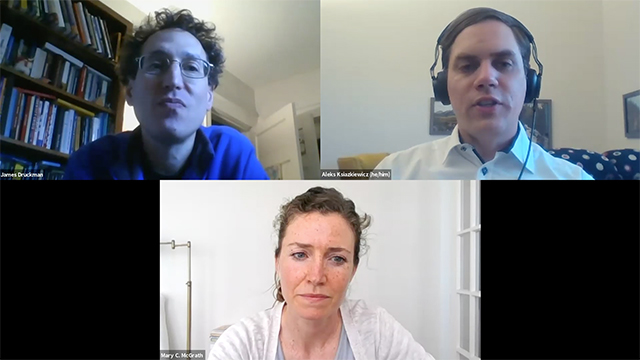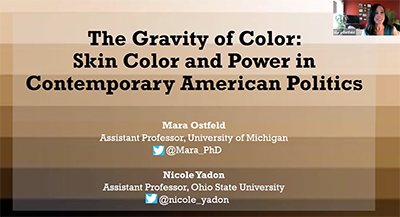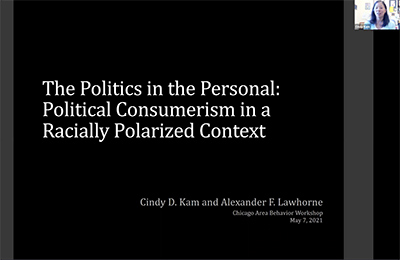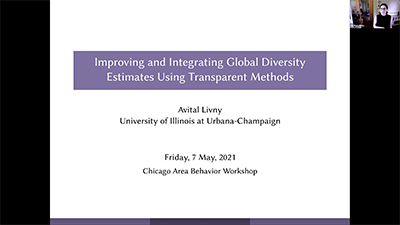Understanding Political Attitudes and Experiences, Diversity, and Collaboration
This year’s workshop highlights novel research by four women political scientists
Get all our news

IPR political scientist James Druckman, University of Illinois at Urbana-Champaign assistant professor of political science Aleks Ksiazkiewicz, and IPR political scientist Mary McGrath at CAB 2021.
In its 15th year, the Chicago Area Social and Political Behavior (CAB) Conference continued its tradition of celebrating and sharing emerging scholarly work in political science. Nearly 180 people attended the May 7 virtual event this year from across the nation.
“It's been an unimaginable year,” said IPR political scientist James Druckman, who organized the workshop, in opening the 2021 CAB. “Throughout the year, I personally felt very privileged to have such a supportive professional community exemplified by the culture this conference has come to embody.”
All four faculty speakers presented some of their new research that aims to better understand people’s political attitudes and experiences, diversity measurements worldwide, and collaborative efforts.
Skin Color and Political Views | Boycotting and Buycotting | Improving Diversity Measurements | Political Effects of Collaboration
 Skin Color and Political Views
Skin Color and Political Views
University of Michigan’s Mara Ostfeld started the event by discussing her research (co-authored with Nicole Yadon of Ohio State University) on the relationship between skin color and individual political preferences- both within and between ethnoracial identity groups.
“To be clear, I'm not suggesting that skin color is more politically consequential or important than ethnoracial identity,” she said.“I am, however, highlighting that skin color is also an important component of people's racialized experiences and the racial disparities that continue to shape American political views.”
Racial politics in America has historically been defined by blunt boundaries between ideas of Whiteness and Blackness, she says. But as the number of people who identify as neither fully Black nor fully White has grown, ethnoracial identity has become a more complicated tool of efforts to police social, economic and political boundaries. Skin color, on the other hand, has remained comparably easy to observe and employ as a social and political cue.
With these shifting features of American ethnoracial dynamics in mind, she and Dr. Yadon put forth a new theoretical framework outlining when and how they expect skin color to shape attitudes toward racialized policies in America. In particular, she emphasized that when it becomes more difficult to determine the boundaries of an ethnoracial group, skin color will become a more important factor in how members of that group form their political views on racialized policies. Along these lines, she provides evidence that skin color is associated political views on racialized policies among Latinos and White Americans.
Yet, the way skin color matters among these individuals hinges on the institutionalized historically afforded to the ethnoracial group in American society. Among those who have experienced more ethnoracial privilege in America, skin color will map on to a desire to protect the group’s ethnoracial privilege. For example, White Americans with darker skin tones (“ambiguous Whites” who feel least secure about their ethnoracial status) were more likely to hold views that distinguish them from non-Whites, including holding conservative political views on racialized issues and supporting former president Trump.
Among those who have historically experienced less ethnoracial privilege, skin color will map to how individuals aspire to situate themselves in American racial politics. For example, Latinos who overestimated how dark their skin color was were less likely to support Trump and had less favorable views of how police use force, while the inverse was true among Latinos who overestimated how light their skin color was. Together their evidence highlights the multidimensional nature of racial dynamics, and the political significance of skin color within racial identity groups.
 Since the Civil Rights movement, boycotts have been a powerful political tool, Vanderbilt professor Cindy Kam said. Today, nearly half of Americans engage in some form of political consumerism in the form of either boycotting or buycotting, which is when a person intentionally seeks out a product or business because of political or social values.
Since the Civil Rights movement, boycotts have been a powerful political tool, Vanderbilt professor Cindy Kam said. Today, nearly half of Americans engage in some form of political consumerism in the form of either boycotting or buycotting, which is when a person intentionally seeks out a product or business because of political or social values.
In light of the heightened attention to racial issues in the United States, Kam shared preliminary findings that demonstrate how racial attitudes influence political consumerism. Kam presented a pair of experiments, fielded in 2015 and then 2020, that examine whether people were more likely to boycott or buycott a hypothetical grocery store that kept products with the Confederate flag on them or removed them from their shelves.
These experiments demonstrated a strong motivation among racial liberals to penalize stores that held onto the Confederate flag and a modest reward for stores that removed it. Racial conservatives were likely to modestly reward a store that kept the Confederate flag but did not consistently punish a store that removed it.
Kam also presented results from a third experiment from 2020 that examined how people reacted to a hypothetical bakery that either agreed to or refused to create products featuring the Confederate flag and Black Lives Matter (BLM) logo. In this study, both racial conservatives and racial liberals were motivated to penalize the store that took actions they disagreed with and reward the store that agreed with them. There was one important exception to this: Refusing the Confederate Flag had little effect among either racial liberals or racial conservatives, suggesting that this behavior may have become a norm.
Overall, Kam says her results demonstrate that for many Americans, the personal has become politicized: Personal economic decisions about which stores to frequent and which products to purchase can be influenced by political attitudes in systematic and sizable ways.
 Improving Diversity Measurements
Improving Diversity Measurements
The University of Illinois at Urbana-Champaign’s Avital Livny began her presentation with “bold” claims about the inaccuracy of diversity measurements. Many existing datasets are biased by systematic measurement error, she said. Additionally, many countries have never collected data about ethnic composition via a national census.
Livny proposes using self-identification data in cross-national surveys to estimate group size and improve diversity measurements. She and her colleagues set out to collect data from survey projects that conducted surveys across multiple countries and across multiple points in time to determine which surveys produce “truer” data. They found 30 nationally representative cross-national surveys conducted across 146 countries over multiple waves dating back to 1973. The data on self-identified ethnicity includes over 5 million respondents and more than 1,750 surveys.
Her diversity estimates show over 85% of cases are statistically significantly different than previous diversity estimates. Livny attributes the difference to the surveys showing more ethnic groups per country. On average, she and her colleagues find about 14 ethnic and racial groups per country, while existing datasets show about five.
Livny predicts her research will show the most significant effects in places that have never collected ethnic composition, including many European countries or countries that have not conducted censuses in the post-colonial period.
Political Effects of Collaboration
IPR political scientist Mary McGrath gave the final talk on the political effects of collaboration, which examines how collaboration impacts people and their interactions with others.
“Collaboration drives politics,” she said. “It allows politics to happen, and it affects what happens.”
McGrath argues that collaboration produces both bonds of obligation and bonds of trust. She said both bonds influence several factors, from the extent to which people are willing to make sacrifices for the sake of another person, to the extent to which they’re willing to give someone the benefit of the doubt.
In a series of experiments in which people worked together to complete small tasks, McGrath finds that collaboration increases willingness to sacrifice, driven by a sense of obligation. In her preliminary investigation on trust, she finds that collaboration increases trust and may increase tolerance of opposing viewpoints.
She also connected her research to the messaging (“We’re all in this together.”) that politicians and public health experts used at the onset of the pandemic to encourage people to wear masks, social distance, and stay home. The problem with that messaging, she says, is that it may encourage people to focus on themselves and what they owe to others who are similarly situated, instead of motivating people through empathy for those disproportionately impacted by the pandemic.
James Druckman is Payson S. Wild Professor of Political Science and IPR associate director and fellow. Mara Ostfeld is an assistant professor of political science at the University of Michigan. Cindy Kam is William R. Kenan, Jr. Professor of Political Science and director of the Research on Individuals, Politics and Society Lab at Vanderbilt University. Avital Livny is assistant professor of political science at the University of Illinois Urbana-Champaign. Mary McGrath is assistant professor of political science and an IPR fellow.
Published: May 27, 2021.


